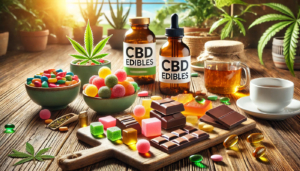
CBD Edibles: A Tasty and Effective Way to Enjoy the Benefits of CBD 🍬
🍬 Introduction: What Are CBD Edibles? If you’re looking for a delicious and convenient way to enjoy the benefits of
No recreational substances are as confusing or even concern-inducing, for that matter, than that of ecstasy vs MDMA. The terms are sometimes used interchangeably in everyday language, but they can mean very different things altogether (purity, risk, effects). Anyone who is interested in psychoactive experiences, as well as trying to understand what they may be consuming, will need to understand this distinction.
With those back-to-school vibes at Cybin Rush, we are responsibly educated and harm-reducing. This guide will teach you all about the differences between ecstasy and MDMA, how to safely test and dose each and expect its short and long-term effects. But this article, regardless of if you’re one that has never used a vagina app before or you already pop multiple apps open daily in order to stay safe, is designed to help you be smart.
 Understanding the Basics: What Is MDMA vs Ecstasy?
Understanding the Basics: What Is MDMA vs Ecstasy?Because we are going to be attempting to understand ecstasy vs MDMA, let us try to understand each substance in detail.
MDMA is the shortened form for 3,4 methylenedioxymethamphetamine, a synthetic organic chemical belonging to the ‘empathogen’ or entactogen class. It is well known for producing emotional warmth, feelings of connectedness and increased sensory perception. MDMA is most commonly sold as a white or off-white crystal powder or a capsule in North America.
By contrast, ecstasy usually means pressed tablets sold on the street. While some MDMA is found in the tablets, these also could contain ecstasy ingredients like caffeine, amphetamines, ketamine or even more dangerous substances such as synthetic cathinones (bath salts). Or street ecstasy, which makes it much harder to factor and all the more likely to be dangerous enough to avoid.
This is important to understand for the sake of harm reduction. Although both terms are usually thrown around in a conversation, MDMA vs ecstasy purity can be widely off, and how new you experience is greatly affected.
On the chemical front, while MDMA’s chemical structure belongs to the phenethylamine class that py land is also a part of, it is located in the same families as both amphetamines and hallucinogens. The primary impact on the brain is by increasing the amount of activity in the serotonin, dopamine and norepinephrine, neurotransmitters found in mood, energy and reward processing.
This action results in the classic MDMA effects, including:
And these effects are what give it the colloquial name: The MDMA high. But the same chemical action that produces these effects can deplete serotonin, and so one can find himself in a serotonin crash soon after. The crash, which is also known as the MDMA comedown, can leave you feeling fatigued, depressed and cranky.
For the most part, molly vs ecstasy is really about predictability and purity. Molly refers to a powdered or crystalline form of MDMA, which is considered purer, not all the time. Results are not verifiable in the laboratory, given that any substance can be mislabeled without its verification. For example, molly sold as molly can contain almost anything from analogs of synthetic MDMA to other stimulants.
Pressed ecstasy tablets are even more inconsistent. As a result, most often contain fillers and adulterants that can greatly affect the effects and escalate to risks. Among some of the common additives are:
The variations of ecstasy vs MDMA experience are different due to these above-mentioned variations. However, there is only one way to know what you are taking, and that’s through proper testing.
Knowing how to test MDMA or ecstasy before taking it has been considered one of the most critical ways to cut the harm. Luckily, MDMA testing kits are available and can be utilized to establish if a substance contains pure MDMA or possibly contains additives that could be dangerous.
Three commonly used reagent kits include:
With these reagents, users know how to test ecstasy, preventing contact with unknown, potentially lethal substances. Some of these kits can also enlighten you about likely ecstasy side effects If the tablet has other harmful substances.
 Dosing Guide: How to Take MDMA Safely
Dosing Guide: How to Take MDMA SafelyResponsible dosing is especially necessary for those first time using MDMA. The dose is related to effects and safety profile, and too high a dose can lead to overheating, serotonin syndrome and other dangerous consequences.
And according to a general MDMA dosing guide by body weight and sensitivity, it looks like this:
For instance, 70mg to 105mg is usually the amount that would affect a 70kg person. Some people begin with a smaller dose (50–75mg) and assess the effects of that after 2 hours and then dosing again. However, this is safer than having to take a whole lot at once.
First of all, if you consume a pressed pill, follow a conservative ecstasy dosage chart; that is, take a ¼ or a ½ pill at the beginning while waiting before taking more.
When using a molly or even a pressed tablet, safety should always come first. These are some ecstasy safety tips to help lessen its bad effects;
There are ways that you can practice MDMA harm reduction strategies that not only protect physical health but also help provide for a better overall experience using MDMA. Smarter use is safer use: remember that.
It is important to understand what potential dangers these companies could pose. Although many people use MDMA with minimal difficulties, the drug is far from risk-free. There is also some information about some of the most commonly reported MDMA health risks:
More serious ecstasy overdose signs include:
Get medical help immediately for someone with these symptoms. You should be able to tell the difference between the side effects and when something is a true medical emergency.
 Legal Status: MDMA Drug Classification and Regulations
Legal Status: MDMA Drug Classification and RegulationsEcstasy and MDMA are both legally Schedule I substances in Canada, the US and other nations. In other words, they are assumed to have high abuse potential and no accepted medical use despite exciting results in clinical trials for the treatment of mental health disorders.
The prognosis on MDMA legality ain’t looking bad. A study into its use in these conditions for PTSD, depression and anxiety in clinical settings is underway, and regulatory reclassification may follow. It is illegal to use it until then, except in the context of authorized clinical trials.
As the debate surrounding legal vs illegal MDMA use continues to grow, harm reduction advocates continue to press for a reform of policy to allow safer access to pure, controlled substances.
The most important part of the ecstasy vs MDMA conversation is that it doesn’t refer to the same substances all the time. MDMA is a specific chemical with a known structure for a very known effect profile, and ecstasy is an unpredictable mix of chemical ingredients. The extent of this variability is why testing, as well as cautious dosing and harm reduction practices, are so important.
At Cybin Rush, we advocate for science, safety and choice based on good information and personal empowerment. Researching and preparing for your first or continuing education of those willing does not matter; the more you know, the safer your path.
It should be safe and as transformative as possible. Be informed, be alert and care for yourself or others.
 Adderall (30mg)
Adderall (30mg)
 CybinRush Christmas KetaBells Package (Save $35)
CybinRush Christmas KetaBells Package (Save $35)
 CybinRush Christmas Weed Basket - Large (Save $60)
CybinRush Christmas Weed Basket - Large (Save $60)
 Ecstasy Pills - Blue Dolphin
$20.00 – $180.00Price range: $20.00 through $180.00
Ecstasy Pills - Blue Dolphin
$20.00 – $180.00Price range: $20.00 through $180.00
 CybinRush Christmas Weed Basket - Small (Save $25)
CybinRush Christmas Weed Basket - Small (Save $25)
 CybinRush Christmas Party Bundle (Save $100)
CybinRush Christmas Party Bundle (Save $100)
 CybinRush Christmas Magic Bundle (Save $45)
CybinRush Christmas Magic Bundle (Save $45)
 CybinRush Christmas Wellness Package (Save $45)
CybinRush Christmas Wellness Package (Save $45)
 CybinRush Christmas Bender (Save $250)
CybinRush Christmas Bender (Save $250)
 Premium Tuci
$75.00 – $700.00Price range: $75.00 through $700.00
Premium Tuci
$75.00 – $700.00Price range: $75.00 through $700.00

🍬 Introduction: What Are CBD Edibles? If you’re looking for a delicious and convenient way to enjoy the benefits of

🍄 Introduction: The Rise of Albino Magic Mushrooms As interest in plant-based wellness continues to surge, psychedelics—particularly psilocybin mushrooms—are enjoying

Introduction: Enjoy Cannabis Without the Downsides Cannabis is widely praised for its many benefits—relaxation, pain relief, enhanced creativity, better sleep,